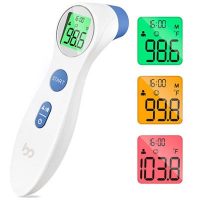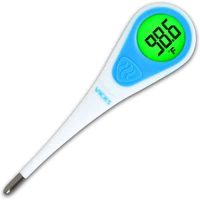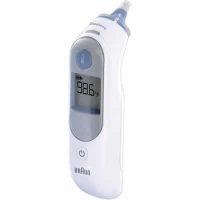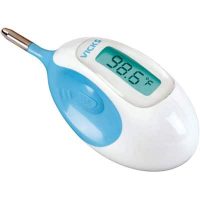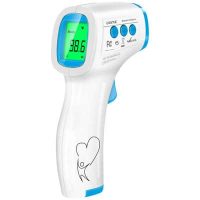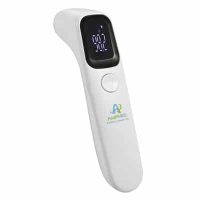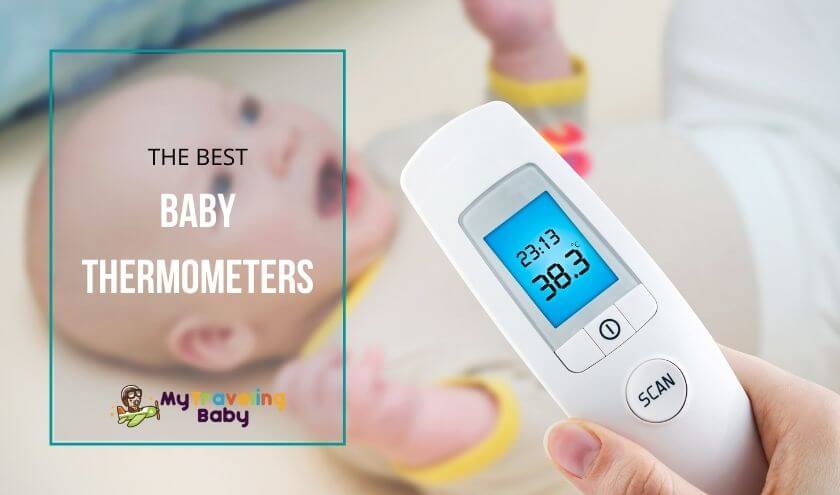
Best Pacifiers For Breastfeeding — Buyers Guide, Review and Comparison
Finding the best pacifiers for breastfeeding babies can be tricky, and nursing moms often have many questions on this topic. They may be concerned about using a pacifier at all when breastfeeding. That said, pacifiers can often provide parents with the ability to soothe a restless or fussy baby without the need for them to be constantly nursed. They can make all the difference to an exhausted breastfeeding mom.
Top Pick
This digital infrared forehead thermometer is perfect for ensuring that your little one’s temperature is where it should be. It’s battery-powered and doesn’t even require contact with the body to attain an accurate reading — perfect for a fidgety baby who just won’t sit still! It features three color displays to indicate the different temperature levels and is readable in both Celsius and Fahrenheit.
- FDA approved.
- Measures both human and object temperature.
- One-second response time.
Product Rating: 4.7/5
| PRODUCT | FEATURES | |
|---|---|---|
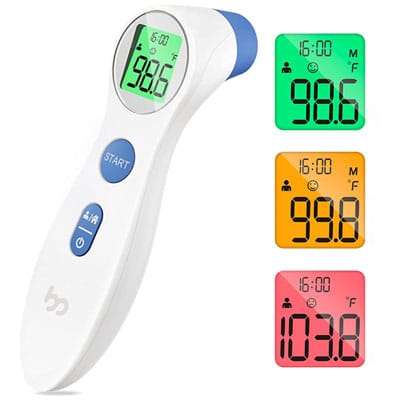 Femometer Touchless Thermometer | Battery: 2 AAA batteries Response time: 1 second Approved: FDA Weight: 3.84 ounces
| CHECK PRICE AT AMAZON Travelling Baby Review |
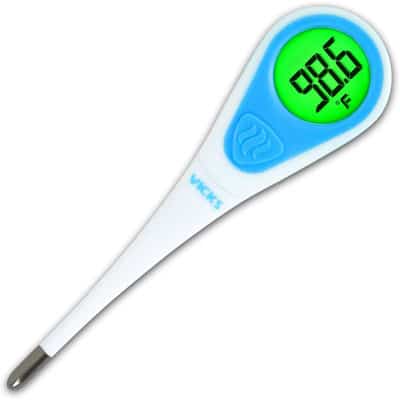 Vicks SpeedRead Digital Thermometer | Battery: 1 LR44 battery Response time: 8 seconds Approved: N/A Weight: 1.76 ounces
| CHECK PRICE AT AMAZON Travelling Baby Review |
 Braun ThermoScan 5 | Battery: 2 AA batteries Response time: Not disclosed Approved: N/A Weight: Not disclosed
| CHECK PRICE AT AMAZON Travelling Baby Review |
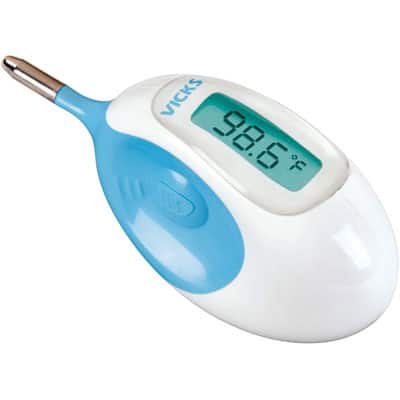 Vicks Baby Rectal Thermometer | Battery: 1 LR44 battery Response time: 10 seconds Approved: N/A Weight: 0.8 ounces
| CHECK PRICE AT AMAZON Travelling Baby Review |
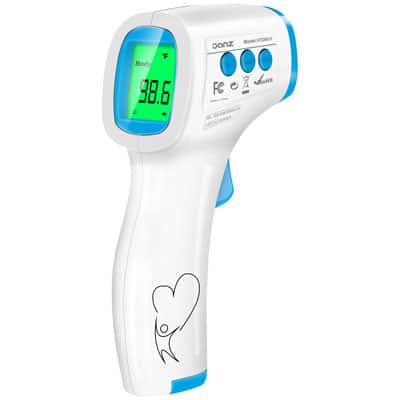 LPOW Forehead Thermometer | Battery: 2 AAA batteries Response time: 1 second Approved: N/A Weight: 5.6 ounces
| CHECK PRICE AT AMAZON Travelling Baby Review |
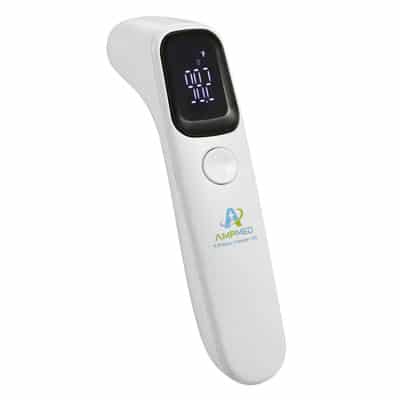 Amplim Hospital Digital Thermometer | Battery: 2 AAA batteries Response time: 1 second Approved: CE, FDA Weight: 3.99 ounces
| CHECK PRICE AT AMAZON Travelling Baby Review |
The Best Baby Thermometers Buying Guide
Once you have a baby you find that there are products available for everything, many of which you discover you never use. However, some products can be a lifesaver and help ease parents’ anxiety when their children are sick — the best baby thermometers are one of these products.
Types of Baby Thermometers
A digital baby thermometer is a perfect addition to your baby arsenal. However, it’s difficult to figure out which is the best pick for you and why that’s the case. To help you out, here is a list of the different types of baby thermometers, as well as their pros and cons:
Rectal Thermometer
Ask any medical expert, and they will tell you a rectal thermometer offers the most accurate reading. In fact, for babies under three months and up to three years, it’s the preferred method of the American Academy of Pediatrics (AAP). This device is designed to be inserted into the butt to take the internal temperature of the body.
Pros
- Accurate in children and adults.
- More reliable readings than other thermometers i.e. underarm.
- Inexpensive.
Cons
- A risk of perforation — though this is rare.
- Many parents aren’t comfortable using this intrusive method
Oral Thermometer
An oral thermometer takes the temperature by being placed under the tongue. These are suitable for those who can keep their mouths closed for a longer period of time, as this is necessary for an accurate reading.
Pros
- Easier to use than an oral or in-ear thermometer.
- Less likely to be influenced by external factors.
- Most accurate baby thermometer method.
Cons
- Can be affected by external factors — drinking something hot or cold.
- Not recommended for young children — under 3 years.
In-Ear Thermometer
An in-ear thermometer takes the temperature inside the ear canal using infrared technology. While you tend to get a higher reading than with the oral method, they are handy for a child who is either unable or unwilling to hold a thermometer in their mouth. That said, they can be tricky for small children due to the limited size of the ear canal.
Pros
- Fast readings.
- More preferable than oral or rectal thermometers.
- Tend to have a higher price point than other types.
Cons
- Must be positioned properly to ensure an accurate reading.
- Not for newborns or babies up to three months.
- Earwax could obscure readings.
Forehead Thermometer
Forehead thermometers use infrared to measure the temperature of the superficial temporal artery, and some are known as non-contact infrared thermometers (NCITs). This ‘point and shoot’ design has become increasingly popular in airports, shops, and stadiums in the wake of the Covid-19 pandemic.
Pros
- Fast readings.
- Easily administered.
- No physical contact — more hygienic.
Cons
- Can be affected by environmental factors i.e. drafts, wind, heating.
Underarm Thermometer
Underarm thermometers work by being placed under the arm of a child or adult to take their temperature. Admittedly, this is the least accurate way to measure body temperature, but the procedure is far more straightforward than oral or rectal methods. Experts suggest using the underarm approach for a quick check.
Pros
- Quick and comfortable.
- Easily administered.
Cons
- Not as accurate as some internal readings i.e. oral, rectal.
Mercury Thermometer
This type of thermometer was once the go-to product for taking temperatures in children, as well as adults — but not anymore.
Exposure to mercury is associated with various health risks. If this type of thermometer became damaged and the mercury leaked, it could potentially poison anyone it came into contact with.
So, if you do still have one of these thermometers, it’s super important to dispose of them responsibly — don’t throw them in the trash.
How To Use a Baby Thermometer
Here is a quick guide on how to use each type of thermometer to ensure that you take an accurate reading:
Rectal Temperature
- Apply a small amount of lubricant to the probe — such as petroleum jelly.
- Place your little one on their tummy across your knees. Place your palm against their lower back to hold them in position.
- With your other hand, turn on the thermometer and carefully insert the probe 0.5 to 1 inches into the anal opening.
- Hold in place gently, once you hear the beep, it can be removed, and the reading checked.
Oral Temperature
- If your child has been eating or drinking, wait 10-15 minutes before taking an oral temperature reading.
- Turn the thermometer on and place the tip gently under the tongue.
- Keep it in place until you hear the beep, then remove and read the temperature.
Underarm Temperature
- Switch on the thermometer and place the small end under your child’s arm, in their armpit.
- Ensure that the thermometer is touching their skin, not their clothing.
- Hold in position until you hear the beep, then remove and read the temperature.
In-Ear Temperature
- Do not use it straight away if your child has been swimming or taking a bath.
- Ensure a clean cover is placed on the cone-shaped end.
- Pull the ear gently backward and place the thermometer in their ear canal.
- Turn on the thermometer, wait for it to beep, remove and read the temperature.
Forehead Temperature
- Ensure the forehead is clean before taking the reading.
- Point the thermometer at the center of the forehead, at the reading distance specified by your owner’s manual.
- Press and hold the button until the beep arrives, remove and check the display.
What To Look For When Choosing a Baby Thermometer
Now that you understand the different types of thermometers, here are a few things you should consider when shopping for one:
Type
We’ve discussed the different types of thermometers and their individual pros and cons, but it’s crucial that you pick the right thermometer for you.
Consider the age of your baby, whether you have other children who also might make use of the thermometer. And, think about how likely your baby will cooperate with that method.
For ease of reference, here’s a quick run-through of the suggested age groups from the AAP (American Academy of Pediatrics) and thermometer suitability:
- Under 3 months, and to six months — rectal, forehead.
- Six months to 36 months — ear, rectal and forehead.
- Four to 5 years — rectal, oral, forehead, and in-ear.
- Five years plus — oral, forehead, or in-ear.
Reading Time
If your baby is fussy and not feeling their best, the last thing you want to do is wrestle with them to take an accurate reading of their temperature. With this in mind, you may want to consider a quick reaction time.
Display
Many thermometers come with a backlit display, which can make reading your baby’s temperature in a dark nursery easier. Some also come with a traffic light system. This not only shows your baby’s temperature but also changes color to correspond with the range that the temperature falls within.
- Green means normal.
- Amber means slightly high.
- Red means very high.
Additional Features
The best thermometers now do far more than just take a temperature, many come with additional features, such as:
- Memory storage — They can record a number of previous temperatures. This means they are great for tracking your little one’s temperature through an illness, as well as allowing you to relay this information to your pediatrician.
- Talking thermometer — If the display on your thermometer is difficult to read, one that reads it out to you can be super handy, especially when you are attempting it in the dark and are exhausted.
- Measures body and object temperature — This can be handy for checking the temperature of food, rooms, or even liquids.
Battery Type
The vast majority of thermometers need standard AA or AAA batteries to work. This is great, as they tend to be the type of battery you would normally have in your home.
Try to avoid thermometers if they require a specific nonstandard battery type, which could be problematic if they run out when you need to use it.
Best Baby Thermometers — Our Top Picks
Finding the best baby thermometer to suit your and your baby’s needs can be a time-consuming task, so we’ve made the job easier, by narrowing down some of our favorites.
Femometer Touchless Thermometer
Best Forehead Thermometer For Baby
This no-contact infrared forehead thermometer is ideal for everyone — your little one, your husband (who insists he’s fine), even grandma who has a headache, the whole family!
It has a large LCD screen, which makes it easy to read day or night. And, the one-second result response combined with the color display — green, amber, and red — helps you figure out quickly whether things are fine or not.
This thermometer can also be used to measure the temperature of objects — think pool water, the garden tiles, the fridge that’s playing up. It’s is also easily readable in both ℃ and ℉.
PROS
- Fast response time — ideal for babies that won’t sit still!
- FDA approved for your peace of mind.
- Straightforward to operate.
- One of the best infant forehead thermometers.
CONS
- Fever alarm could be more prominent.
Vicks SpeedRead Digital Thermometer
Best Digital Thermometer For Baby and Toddler
If you have children of different ages, the Vicks digital thermometer could be of interest. It can be used as an oral, underarm, or rectal thermometer, giving you the freedom to use the thermometer in the most appropriate way for you.
It’s water-resistant for easy cleaning and features an automatic shut-off function, which means battery life is never wasted. The color-coded reader allows you to interpret results quickly and with minimal fuss.
This thermometer also comes with a storage case, offering protection and keeping it free from dirt and dust. And, the one-year warranty offers you peace of mind should any issues arise.
PROS
- Memory recall function.
- Economical price tag.
- Includes storage case and battery.
CONS
- Lengthy response time
Braun ThermoScan 5
Best Ear Thermometer For Baby
If you’re seeking an alternative to an oral or rectal thermometer, an in-ear device might be a solution.
Proprietary technology helps you position the probe in the ear correctly for accurate readings. And, Braun uses a pre-warmed tip to make the whole experience more comfortable for your little one.
The thermometer is also easy to clean, thanks to the disposable filter covers — of which, a pack of 20 replacements is included. What’s more, while the screen doesn’t feature a backlight, the oversized display permits rapid reading of the results.
PROS
- Fast, gentle, and accurate readings.
- Stores last reading for a quick comparison.
- Switch between Celsius and Fahrenheit.
CONS
- Disposable probe covers — means an extra cost.
Vicks Baby Rectal Thermometer
Best Rectal Thermometer For Baby
While rectal thermometers may appear intrusive, it’s the suggested method if you have a newborn. Hence, the Vicks rectal thermometer may appeal.
The length of the probe is ideal for those moments when you’re really not sure how far is too far, or not enough — if you know what I mean. The short and flexible design ensures minimal discomfort during insertion and the correct depth for an accurate measurement.
The large display is also backlit, meaning that you can easily read it in lowlight conditions — perfect if your little one starts burning up through the night.
PROS
- Compact device — ideal for storing in a diaper bag.
- The best thermometer method for newborns.
- Small probe — doesn’t upset baby.
CONS
- One of the longer response times
LPOW Forehead Thermometer
Best User-Friendly Baby Thermometer
When your child seems under the weather, the last thing you need is a digital thermometer that requires a degree in technology to operate. A ‘point and shoot’ style, like the LPOW forehead thermometer, permits faff-free measuring.
This no-contact device measures from a distance of up to 5 cm centimeters and provides a reading in one second, which is perfect for a fussy, grizzly baby that just won’t cooperate.
It also includes memory storage of up to 50 readings, meaning you can track your baby’s temperature over a period of time — removing any worry of manual records and misplacing them.
And, as well as measuring body temperature, you can use this for non-human objects, such as food, liquid, or for checking the warmth in your living space.
PROS
- Accuracy — +0.4 degrees Fahrenheit.
- Multiple measuring modes.
- LCD display with backlight.
CONS
- The screen protector sticker is tricky to remove.
Amplim Hospital Digital Thermometer
Best Medical-Grade Thermometer
This non-invasive and touch-free thermometer is medical grade and FDA and CE approved, giving you peace of mind.
Its no-contact measuring design is more comfortable and hygienic than rectal, oral, ear, or armpit thermometers. Plus, the sleek shape of the device is different from the typical ‘gun patrol’ type of thermometer, which also means it’s convenient to take on the go.
And, it comes with plenty of features — a 32-read storage for keeping tabs on your little one’s temperature, Celsius or Fahrenheit measuring — you choose your preference, plus a fever alarm. And, readings are produced pretty much instantly, in only one second, which means no waiting.
PROS
- CE and FDA approved.
- Medical grade non-contact thermometer.
- Sleek, portable design.
CONS
- The display could be brighter.
Conclusion
Ensuring that your baby is happy and healthy is your number one goal as a parent, and having a thermometer to hand is one way to keep a check on them. That said, it’s not a substitute for medical advice, so if you are concerned, contact your doctor or pediatrician.
When making your purchase, consider carefully the type of thermometer that will best suit your baby and their needs. It could be that your baby would be more suited toward a non-contact thermometer. Alternatively, a more traditional in-ear or rectal thermometer might be best.
Also, do you need one that has additional features such as a backlit display or that stores the last few temperature readings — handy if you are tracking a sick child over a period of time.
The best baby thermometers are the ones that suit you and your baby’s needs, fits your budget, and it’ll be the handiest tool in your arsenal. However, if you are concerned about your baby, seek professional advice.
Best Baby Thermometers FAQs
Which Type of Thermometer Is Most Accurate For Babies?
There are many thermometers around, but the American Academy of Pediatrics recommends using a rectal, underarm, or in-ear thermometer for children three months to 3 years old as these are the most accurate.
Are Forehead Thermometers Accurate For Babies?
Forehead thermometers provide an accurate reading for children three months to 3 years, and it has been shown that they can also provide an accurate reading for babies under this age too.
What Is Normal Temperature For a Baby?
The following are the normal ranges for each method:
- Oral — 95.9ºF (35.5ºC), up to 99.5ºF (37.5ºC).
- Underarm — 94.5ºF (34.7ºC), up to 99.1ºF (37.3ºC).
- Rectal — 97.9ºF (36.6ºC), up to 100.4ºF (38.0ºC).
- In-ear — 96.4ºF (35.8ºC), up to 100.4ºF (38.0ºC).
Where Is the Most Accurate Place To Take a Baby’s Temperature?
Rectal temperatures are considered the most accurate as they are the least likely to be affected by external factors. However, foreheads are the next most accurate, and ear temperatures can also be precise — if conducted properly. Armpit temperatures are the least reliable, but they’re useful for screening.

